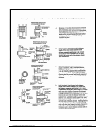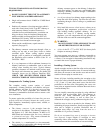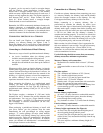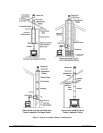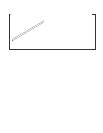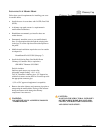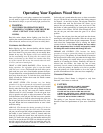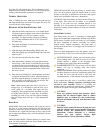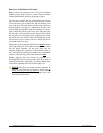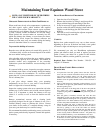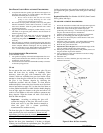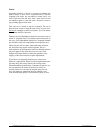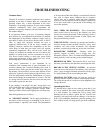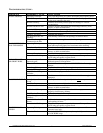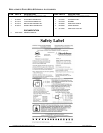
HearthStone Quality Home Heating Products, Inc ® Equinox Model 8000
18
good, hot fire will clean the glass. We recommend a visual
inspection (and cleaning if necessary) of your stovepipe and
chimney after the break-in procedure is completed.
NORMAL OPERATION
Prior to loading the stove, make sure the ash grate and the
ash compartment door are closed. If left open, the stove will
over-fire and will suffer damage.
BUILDING A FIRE FOR EVERYDAY USE
1) Open the front door and place five or six double sheets
of tightly twisted newspaper in the center of the firebox.
Arrange kindling in a crisscross pattern over the
newspaper. Use approximately 10 pieces of kindling,
1/2" (13 mm) in diameter and 10" to 20" (254 mm to
508 mm) long.
2) Fully open the primary air control by moving it
completely to the left.
3) Light the paper under the kindling. Briefly leave the
front door slightly ajar until the kindling burns and draft
begins to pull.
4) Close the door and allow the fire to burn.
5) Once the kindling is burning well, open the front door
and add logs - small at first, to build the fire up. Ensure
you keep the logs away from the glass in front in order
for the air-wash system to work properly. Keep the front
and side doors, and ash compartment door closed while
the stove is in use.
6) Once the fire is burning well, use the primary air control
to regulate the desired rate of burn. Move the handle to
the left to open the primary air control for a high rate of
burn; or push it to the right for a low rate of burn. The
air control does not close completely.
Note: When opening the front door to reload or re-
arrange logs, it is advisable to open the door just a
crack, pause for a moment, then open the door
completely. This procedure allows the firebox to clear
of smoke before the door is open fully. In addition,
reloading on a bed of hot, red coals reduces smoking
time and brings fresh fuel up to a high temperature
rapidly.
BURN RATE
HIGH BURN: Fully load the firebox with wood on a bed of
hot coals or on an actively flaming fire and fully open the
primary air control by moving it all the way to the left, away
from the ash lip. A high burn rate once or twice a day to heat
the stovepipe and chimney fully, will help minimize creosote
accumulation.
MEDIUM HIGH BURN: With the primary air control in the
open, left most position, push the control handle about ¼ to
½ the distance to the right.
MEDIUM LOW BURN: With the primary air control in the
open, left most position, push the handle about ¾ of the
distance to the right. A medium-low burn rate is the typical
setting and is preferable if the stove is unattended.
LOW BURN: Push the primary air control inward all the way
to the right. This closes the air shutter to its minimum
opening. A low burn rate over extended periods is not
advisable as it can promote the accumulation of creosote.
Inspect the venting system frequently if using low burn rates
consistently.
OVER-FIRE CAUTION
Over-firing means the stove is operating at temperatures
above the recommended temperatures outlined in the BURN
RATE section. Carefully avoid over-firing, as it will damage
the stove. Symptoms of chronic over-firing can include
cracked stones, warped components, short burn times, a
roaring sound in the stove or stovepipe, and discoloration of
the stovepipe.
Excessive draft, inappropriate fuel, and operator error can
cause over-firing. Correct an over-fire situation as follows:
EXCESSIVE DRAFT: Contact your local dealer to have
a draft reading taken. Any draft in excess of 0.1 Water
Column requires a damper in the stovepipe. Some
installations may require more than one damper.
INAPPROPRIATE FUEL: Do not burn coal; kiln dried
lumber, wax logs or anything other than natural
cordwood.
OPERATOR ERROR: Ensure all the gaskets are in good
condition. Replace worn out or compressed gaskets. Do
not burn the stove with the front or side door, ash
compartment door, or the ash grate in the open position.
If you suspect that your stove is over-firing, contact your
dealer immediately. Damage caused by over-firing is not
covered by your warranty. Results of over-firing can
include warped or burned out internal parts, cracked stones,
discolored or warped external parts, and damaged finish.
CAUTION:
Never use gasoline, lantern fuel, kerosene, diesel,
heating fuel oil, charcoal lighter fluid or similar
liquids to start, or ‘freshen up’ a fire in this heater.
Keep all such liquids well away from the heater while
it is in use.
CAUTION:
Install a carbon monoxide detector if using the stove
with the optional spark screen installed (front door
opened). Follow the manufacturer’s installation
instructions. Carbon Monoxide is a colorless,
odorless gas that replaces oxygen. High
concentrations of Carbon Monoxide are lethal.



